1a: CONTACT - Greeting
1. Rejects contact - growls and/or trying to bite.
2. Avoiding contact - Shy and redrawing.
3. Accepting contact - not engaged but does not redraw.
* 4. Takes contact self or when handler takes contact. Balanced.
5. Intensive contact behaviour against the test leader, can jump and whine.
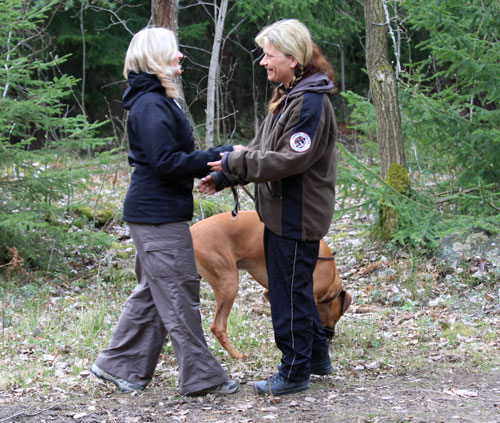
1b: CONTACT - Co-operation
1. Does not follow despite several attempts to allure.
2. Follows reluctant. Strives towards handler or different direction.
* 3. Follows the whole distance, are neutral.
4. Follows willingly. Does engage.
5. Follows willingly. Showing intense interest towards test leader, jumps, whine.
1c: CONTACT - Handling
1. Rejects. Growls and/or trying to bite.
* 2. Avoiding, redrawing, seeking support by the handler.
3. Accepting. Are neutral.
4. Accepting. Answering with contact behaviour.
5. Accepting. Intensive contact behaviour towards test leader.
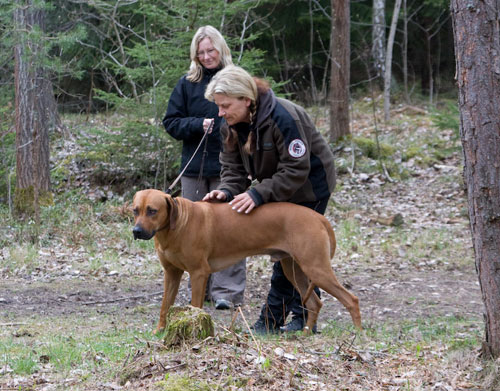
2a: PLAYING - Disposition to play
1. Does not play.
2. Does not play but shows interest.
3. Plays - starts slowly but becomes active.
* 4. Playing active, starts quickly.
5. Playing very active, starts very quickly.
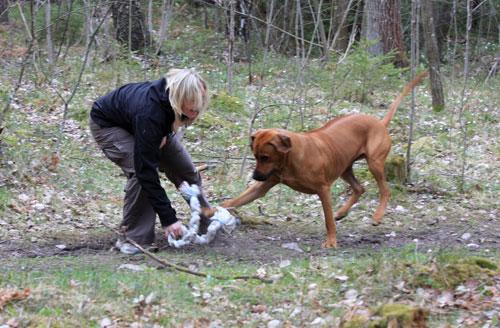
2b: PLAYING - Catching/ holding/grabbing (object)
1. Does not grab.
* 2. Doesn't grab but sniffs on the object.
3. Grabbing carefully or nipping the object.
4. Grabbing directly with full mouth.
5. Grabbing directly, Biting the object.
2c: PLAYING - Tug-of-war (object)
1. Does not grab.
* 2. Bites carefully, releases it's hold, holding on again, don't stride.
3. Bites - strides, releases it's hold, bites again.
4. Grab directly with full mouth, strides until test leader releasing the object.
5. Grab directly with full mouth, tugs, stride until test leader releasing the object.
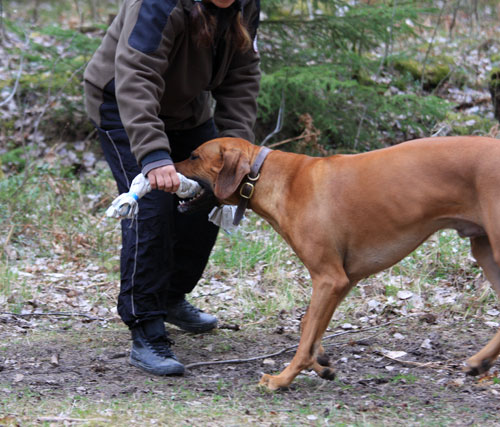
3a: HUNTING - Chasing (first time of two)
* 1. Doesn't start.
2. Does start but interrupt.
3. Does start or run slowly. Can increase speed. Goes all the way.
4. Starts with high speed, targeted - slows down at the prey.
5. Starts directly with high speed. Runs past the prey. Can turn around.

3b: HUNTING - Catching/holding/grabbing (object), (first time of two)
* 1. Ignores the prey / doesn't approach the prey.
2. Doesn't grab but sniffs on the object.
3. Grabs doubtfully or with time delay.
4. Grabs directly, releases the object.
5. Grabs directly, holding on for at least 3 seconds.
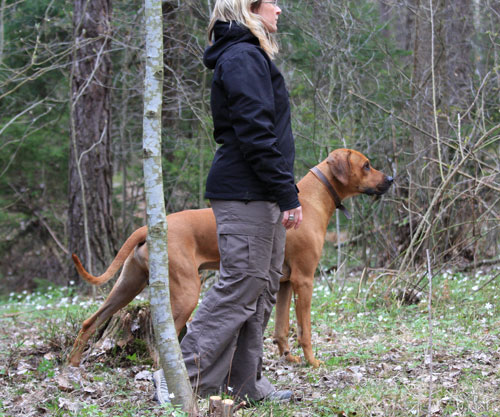
3a: HUNTING - Chasing (second time of two)
* 1. Doesn't start.
2. Does start but interrupt.
3. Does start or run slowly. Can increase speed. Goes all the way.
4. Starts with high speed, targeted - slows down at the prey.
5. Starts directly with high speed. Runs past the prey. Can turn around.
3b: HUNTING - Catching/holding/grabbing (object), (second time of two)
* 1. Ignores the prey / doesn't approach the prey.
2. Doesn't grab but sniffs on the object.
3. Grabs doubtfully or with time delay.
4. Grabs directly, releases the object.
5. Grabs directly, holding on for at least 3 seconds.
4: ACTIVITY
1. Are inattentive, uninterested, inactive.
* 2. Are attentive and calm - stands, sits or laying down.
3. Are attentive and mostly calm. Occasional raising of activity.
4. Are attentive, a bit restless. Strolling after a while.
5. Are restless. Changing activity quickly.
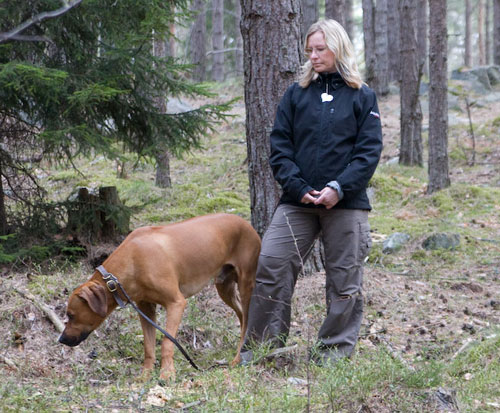
5a: PLAYING AT A DISTANCE - Interest
1. Doesn't interest in figurant. Uninterested.
* 2. Control, interruptions occurs.
3. Interested, follows the figurant without interruptions.
4. Interested, wants to go. Occasional intentions to start.
5. Very interested. Wants to go. Repeatedly intentions to start.
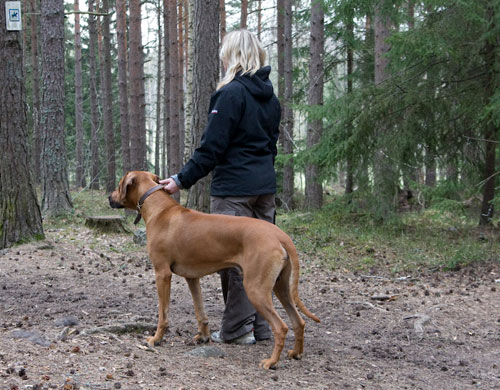
5b: PLAYING AT A DISTANCE - Threat/aggressivness
* 1. No barking or growling.
2. Occasional barks and/or growling during the first part of the moment.
3. Occasional barks and/or growling during the first and second part of the moment.
4. Shows threat- behaviour, barks and growling during the first part of the moment.
5. Shows threat- behaviour, barks and growling during the first and second part of the moment.
5c: PLAYING AT A DISTANCE - Curiosity
1. Doesn't approach figurant without help. Uninterested.
2. Approach when figurant talks and plays boll with an object.
* 3. Approach towards the hidden but speaking figurant.
4. Approach figurant with the a low body and/or with time delay.
5. Approach figurant with no help.
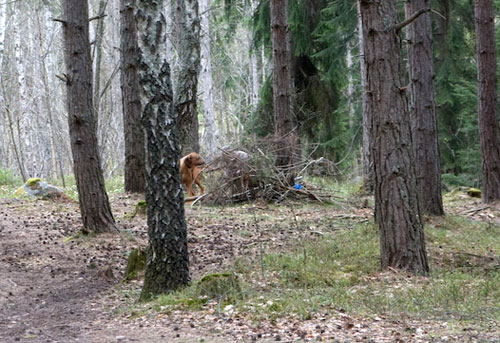
5d: PLAYING AT A DISTANCE - Disposition to play
1. Doesn't show any interest.
* 2. Doesn't play but shows interest.
3. Plays, grabbing carefully, releasing, doesn't stride.
4. Grab directly. Can release and take again, Strides.
5. Grab directly with full mouth. Strides and doesn't release.
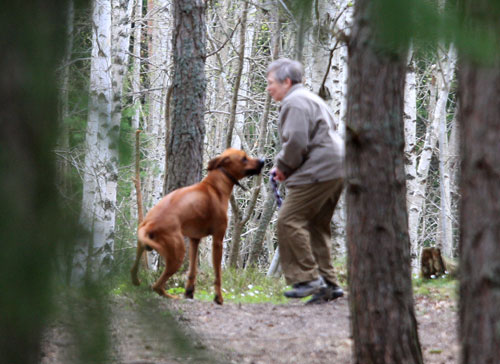
5e: PLAYING AT A DISTANCE - Co-operation
1. Doesn't show any interest.
* 2. Becoming active but does interrupt.
3. Are active when figurant is active.
4. Are active with the figurant interest also toward when figurant is passive.
5. Urge passive figurant to continue the play.
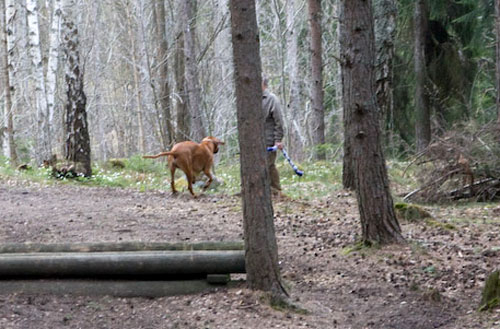
6a: SURPRISE - Fear
1. Stops. Short stop.
2. Crouch down and stops.
* 3. Does an evasive action without turning away the look.
4. Escapes no more than 5 meters.
5. Escapes more than 5 meters.
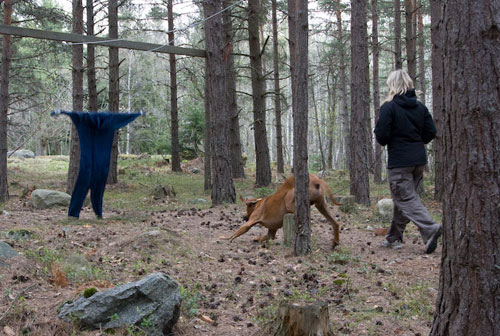
6b: SURPRISE - Threat/aggressiveness
1. Shows no threat behaviour.
2. Show occasional threat behaviours.
* 3. Shows several threat behaviours during a longer period.
4. Shows several threat behaviours and some attack.
5. Shows threat behaviours and attacks which can be finished with a bite.
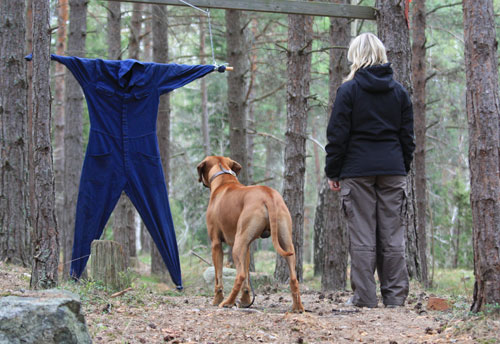
6c: SURPRISE - Curiosity
1. Approach when handler are laying down the overall / don't approach.
2. Approach when handler are sitting down and speaking with the overall - alluring the dog.
* 3. Approach the overall when handler are standing beside.
4. Approach the overall when the handler has gone half the distance.
5. Approach the overall without any help.
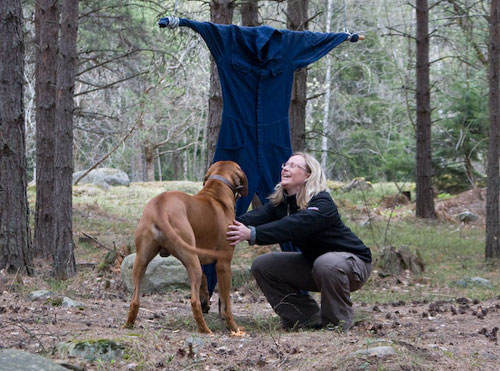
6d: SURPRISE - Remaining fear
* 1. No change of speed or any evasive action.
2. A little curve, or a little change of tempo, or looking away sometimes during the passages.
3. A curve, or a change of tempo at the first passage. Less deviation at the second passage.
4. A curve, or a change of tempo during at least two passages without reduced intensity between moments.
5. Shows a great deal of fear or increased fear after all passages.
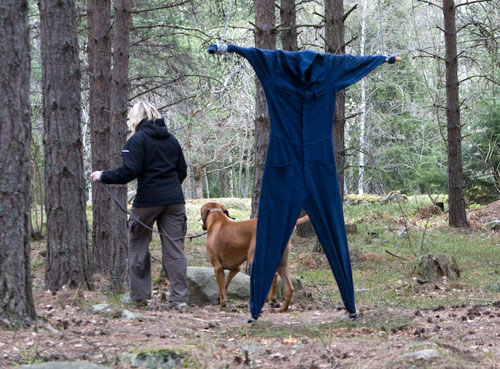
6e: SURPRISE - Remaining interest
1. No interest for the overall.
* 2. Stops. Smelling/ looking at the overall at one occasion.
3. Stops. Smelling/ looking at the overall at least during two occasions.
4. Bites / play against the overall. Interest reduces gradually.
5. Bites / play with the overall during two or more passages.
7a: SOUND SENSIBILITY - Fear
* 1. Don't stop or short stop.
2. Crouch down and stops.
3. Does an evasive action without turning away the look.
4. Escapes no more than 5 meters.
5. Escapes more than 5 meters.
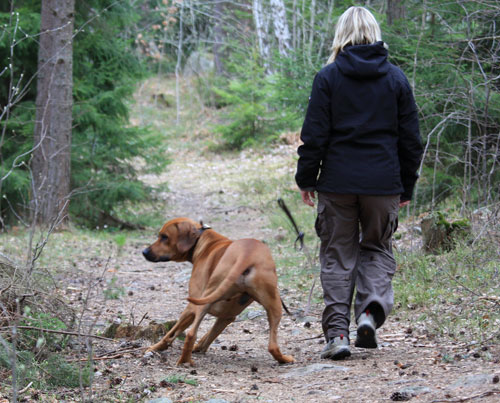
7b: SOUND SENSIBILITY - Curiosity
1. Doesn't approach.
2. Approach when handler are sitting down and speaking with the rattle - alluring the dog.
3. Approach the rattle when the handler stands beside it.
4. Approach when the handler has gone half the distance.
* 5. Approach the rattle without help.
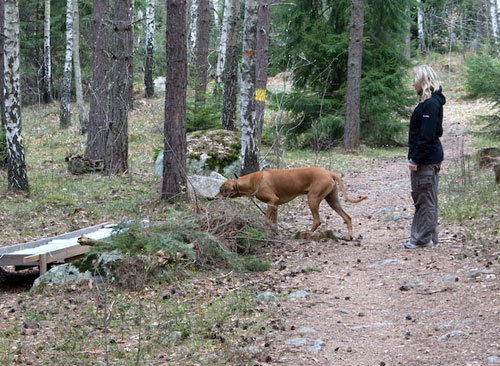
7c: SOUND SENSIBILITY - Remaining fear
* 1. No change of speed or any evasive action.
2. A little curve, or a little change of tempo, or looking away sometimes during the passages.
3. A curve, or a change of tempo at the first passage. Less deviation at the second passage.
4. A curve, or a change of tempo during at least two passages without reduced intensity between moments.
5. Shows a great deal of fear or increased fear after all passages.
7d: SOUND SENSIBILITY - Remaining interest
* 1. No interest for the source of sound.
2. Stops. Smelling/ looking at the source of sound at one occasion.
3. Stops. Smelling/ looking at the source of sound at least during two occasions.
4. Bites / play against rattle. Interest reduces gradually.
5. Bites / play with the rattle two or more passages.
8a: GHOSTS - Threat/aggressiveness
1. Shows no threat behaviour.
* 2. Show occasional threat behaviours.
3. Shows several threat behaviours during a longer period.
4. Shows several threat behaviours and some attack.
5. Shows threat behaviours and several attacks.
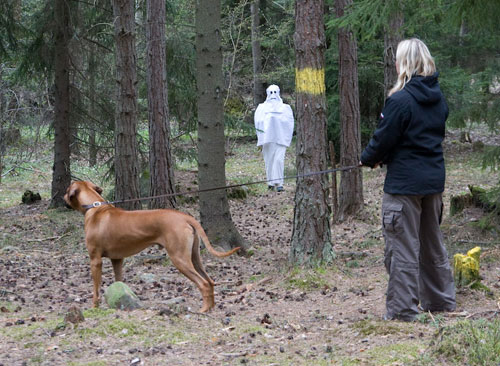
8b: GHOSTS - Control
1. Occasional controls afterwards no interest/cuts off.
2. Looks at the ghost now and then.
3. Controls/acts against the ghosts. Long interruptions.
4. Controls/acts against both the ghosts. Shorter interruptions.
* 5. Controls/acts against both the ghosts during the whole moment.
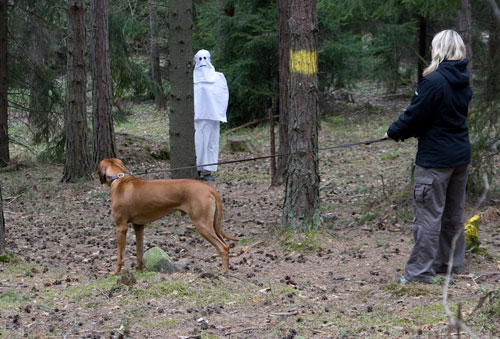
8c: GHOSTS - Fear
* 1. Stays mainly in front of or beside the handler.
2. Stays mainly in front of or beside the handler. Some adjustment of distance.
3. Stays mainly in front of, or beside the handler. Oscillate between start to escape and control.
4. Stays mainly behind the handler. Oscillate between start to escape and control.
5. Escapes more than the length of the lead. Can try to get support from audience or leaving the place.
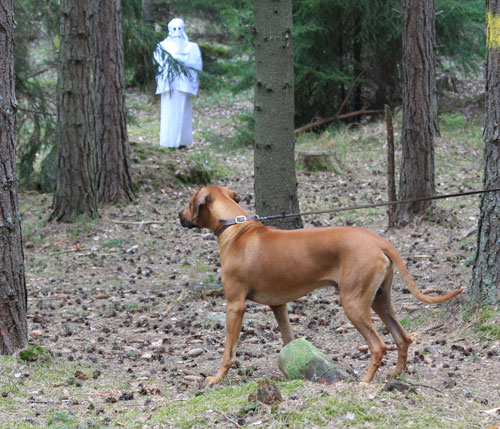
8d: GHOSTS - Curiosity
1. Approaches when handler has taken the disguise off the figurant.
2. Approaches when handler are talking to figurant/alluring the dog.
3. Approach the ghost when handler stands beside.
4. Approach the ghost when handler has gone half the distance.
* 5. Approach the ghost without any help.
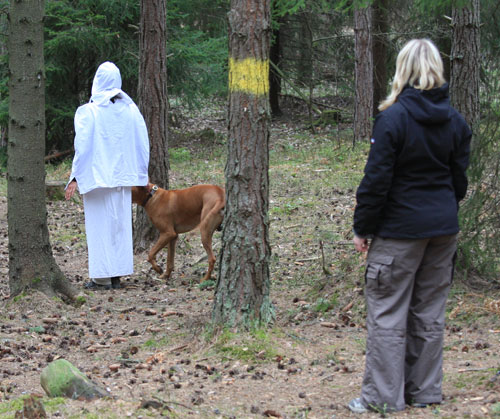
8e: GHOSTS : Contact
4. Tar själv kontakt med figuranten.
1. Rejects or trying to avoid contact.
2. Accepting contact – Not engaged but doesn’t redraw.
3. Returning contact when figurant bids.
* 4. Takes contact self. Balanced.
5. Intensive contact behaviour against the figurant, can jump and whine.
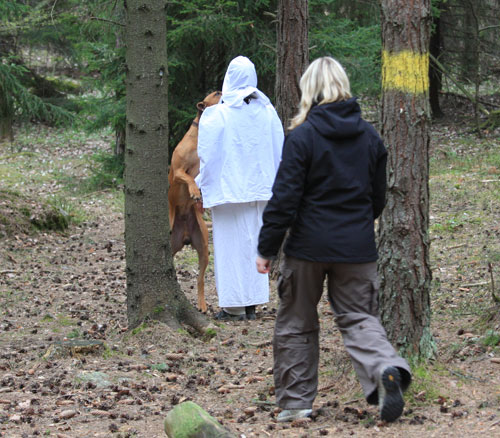
9a: PLAYING - Disposition to play
1. Does not play.
2. Does not play but shows interest.
* 3. Plays – starts slowly but becomes active.
4. Playing active, starts quickly.
5. Playing very active, starts very quickly.
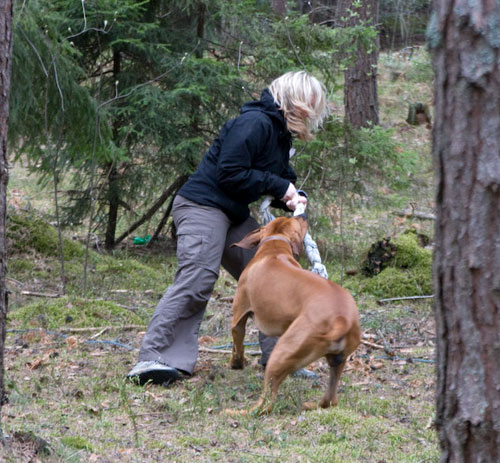
9b: PLAYING - Catching/ holding/grabbing (object)
1. Does not grab.
* 2. Doesn't grab but sniffs on the object.
3. Grabbing carefully or nipping the object.
4. Grabbing directly with full mouth.
5. Grabbing directly, Biting the object.
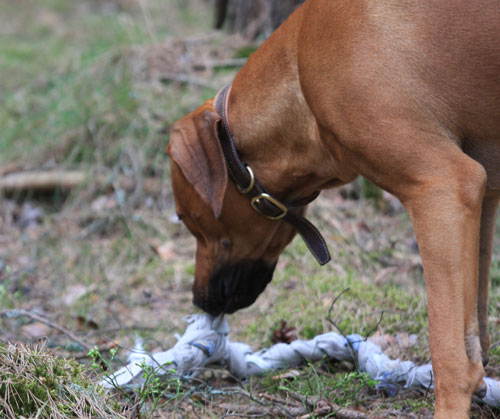
10: Shots
* 1. Shows no affects. Quick control and then totally unaffected.
2. Controls that disappear after the first shots. Breaks but takes up started activity.
3. Decreasing reactions on the shots/direct interest toward the marksman/return back to playing/passivity.
4. Interrupts activity/gets locked with the marksman. Can't go back to playing/passivity.
5. Remaining anxiety after several shots. Interrupts after obvious tendency to escape/renounce shots.